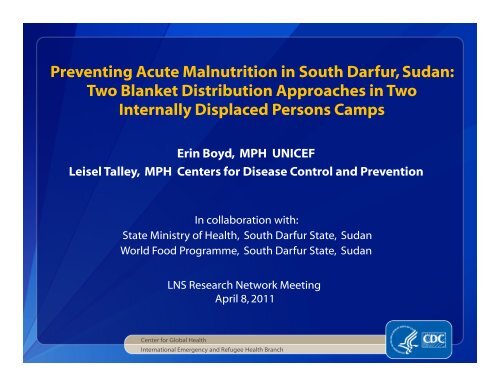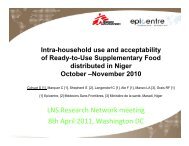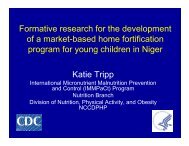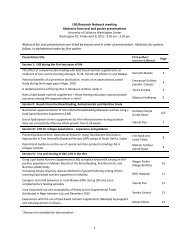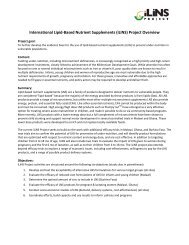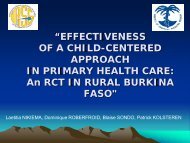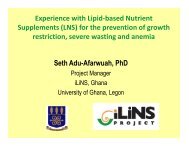Preventing Acute Malnutrition in South Darfur ... - The iLiNS Project
Preventing Acute Malnutrition in South Darfur ... - The iLiNS Project
Preventing Acute Malnutrition in South Darfur ... - The iLiNS Project
You also want an ePaper? Increase the reach of your titles
YUMPU automatically turns print PDFs into web optimized ePapers that Google loves.
<strong>Prevent<strong>in</strong>g</strong> <strong>Acute</strong> <strong>Malnutrition</strong> <strong>in</strong> <strong>South</strong> <strong>Darfur</strong>, Sudan:<br />
Two Blanket Distribution Approaches <strong>in</strong> Two<br />
Internally Displaced Persons Camps<br />
Er<strong>in</strong> Boyd, MPH UNICEF<br />
Leisel Talley, MPH Centers for Disease Control and Prevention<br />
In collaboration with:<br />
State M<strong>in</strong>istry of Health, <strong>South</strong> <strong>Darfur</strong> State, Sudan<br />
World Food Programme, <strong>South</strong> <strong>Darfur</strong> State, Sudan<br />
LNS Research Network Meet<strong>in</strong>g<br />
April 8, 2011<br />
Center for Global Health<br />
International Emergency and Refugee Health Branch
Objective<br />
<br />
Assess the impact of blanket distribution of Lipid-based Nutrient<br />
Supplements (LNS) and Improved Dry Rations (IDR) on prevent<strong>in</strong>g<br />
<strong>in</strong>creases <strong>in</strong> acute malnutrition dur<strong>in</strong>g the hunger season on a<br />
population level.
Program Design<br />
Implement blanket supplementary feed<strong>in</strong>g <strong>in</strong> 2<br />
<strong>in</strong>ternally displaced persons camps <strong>in</strong> <strong>South</strong> <strong>Darfur</strong><br />
dur<strong>in</strong>g the hunger season (May-September, 2009)<br />
Monthly distribution for 4 months<br />
One camp: Improved dry ration<br />
One camp: Lipid-based nutrient supplement<br />
Follow a cohort of children <strong>in</strong> each camp on a<br />
monthly basis to assess anthropometric status<br />
Children 6-59 months of age received ration per standard protocol<br />
Only children 6-36 months of age enrolled <strong>in</strong> cohort
Improved Dry Ration (IDR)<br />
Improved dry ration:<br />
CSB, oil, sugar and dried-skimmed milk powder (DSM)<br />
DSM provided an animal prote<strong>in</strong><br />
Mixed with water and cooked<br />
Prior to CSB++ production<br />
WFP delivered pre-packaged ready to distribute
Lipid-based Nutrient Supplement<br />
(LNS): Plumpy’doz<br />
Ready-to-Use-Food<br />
Supplement to local diets not meal replacement<br />
Peanut-based, fortified lipid-based nutrient spread<br />
Prevention of moderate malnutrition<br />
Packaged <strong>in</strong> a 325 gm cup (weekly ration)
Daily Energy, Prote<strong>in</strong> and Fat Content<br />
LNS<br />
(46 g)<br />
IDR<br />
(180 g)<br />
Energy (kcal) 247 785<br />
Prote<strong>in</strong> (g) 5.9 28.8<br />
Fat (g) 16 27.4
Target Population:<br />
Otash (IDR) and Al Salam (LNS) Camps<br />
Both camps with<strong>in</strong> 20 kms of Nyala town<br />
Population<br />
Total<br />
Under five<br />
Otash 70,134 14,027<br />
Al Salam 62,876 12,575<br />
Regular movement between to Nyala for casual labor<br />
Services: WASH, protection, PHC/nutrition (OTPs)<br />
General food distribution
Target Population:<br />
Nutrition Survey Data 2008 †<br />
Intervention<br />
LNS<br />
IDR<br />
2008 GAM<br />
July<br />
(hunger)<br />
19.2<br />
(15.7- 23.1)<br />
19.5<br />
(16.1- 23.5)<br />
2008 GAM<br />
December<br />
(harvest)<br />
7.4<br />
(5.3- 10.3)<br />
9.8<br />
(7.3- 12.9)<br />
†<br />
NCHS reference
Sample size<br />
Methods<br />
Diggle repeated measures longitud<strong>in</strong>al analysis<br />
Difference <strong>in</strong> the mean<br />
M<strong>in</strong>imum sample size 150 children 6 – 36 months of age<br />
Registration of all children
Exclusion criteria<br />
Analysis<br />
LNS : 141 children delay <strong>in</strong> receipt of distribution<br />
WHZ
Results<br />
Children wait<strong>in</strong>g for measurement, Otash camp
Cohort<br />
IDR<br />
LNS*<br />
Registered 895 754<br />
Excluded malnourished<br />
at enrollment<br />
68 57<br />
Distribution 2 607 318<br />
Distribution 3 441 275<br />
Distribution 4 547 273<br />
Total with 4<br />
measurements<br />
159 187<br />
*One sector of 141 children were removed from analysis because of delayed registration
Sex Distribution<br />
Intervention Boys Girls Boy: Girl<br />
Ratio<br />
LNS<br />
47.17% 52.83% 0.9<br />
IDR<br />
53.48% 46.52% 1.1<br />
Chi square: 1.37 p value= 0.24
Mean Age at Enrollment<br />
Intervention<br />
Mean Age (range)<br />
Standard<br />
Deviation<br />
LNS 24.03 (6-36) 8.2<br />
IDR 23.70 (6-36) 8.3<br />
T-test p value= 0.72
Mean Weight for Height Z Scores (WHO 2005)<br />
Distribution<br />
LNS<br />
Mean (95% CI)<br />
IDR<br />
Mean (95% CI)<br />
P value<br />
1 -1.03<br />
-1.18<br />
(-1.18, -0.88) (-1.33, -1.03)<br />
2 -0.94<br />
(-1.10, -0.79)<br />
3 -0.93<br />
(-1.09, -0.77)<br />
4 -0.84<br />
(-1.0, -0.68)<br />
-1.23<br />
(-1.39, -1.07)<br />
-1.21<br />
(-1.35, -1.06)<br />
-1.22<br />
(-1.37, -1.08)<br />
0.17<br />
0.014<br />
0.013<br />
0.001
Difference of Difference, Weight for<br />
Height Z Scores (WHO 2005)<br />
Distribution<br />
<strong>in</strong>terval<br />
Mean Difference<br />
P Value<br />
1 to 2 -0.13 0.25<br />
1 to 3 -0.13 0.19<br />
1 to 4 -0.23 0.02
Nutrition Survey Data 2008-2010 †<br />
Intervention<br />
LNS<br />
2008 GAM<br />
July<br />
(hunger)<br />
2008 GAM<br />
December<br />
(harvest)<br />
2009 GAM<br />
July<br />
(hunger)<br />
2010 GAM<br />
January<br />
(harvest)*<br />
19.2<br />
7.4<br />
11.4<br />
8.5<br />
(15.7-23.1) (5.3-10.3) (9.4-13.6) (6.5-10.5)<br />
IDR<br />
19.5<br />
(16.1-23.5)<br />
9.8<br />
(7.3-12.9)<br />
14.7<br />
(12.6-17.2)<br />
11.7<br />
(8.8-14.7)<br />
†<br />
NCHS reference<br />
* Post harvest delayed <strong>in</strong>to 2010
Results Summary<br />
No statistical difference <strong>in</strong> the mean WHZ at<br />
basel<strong>in</strong>e between camps<br />
Statistically significant difference <strong>in</strong> mean<br />
WHZ at distributions 2, 3 and 4 between<br />
camps<br />
Statistical difference <strong>in</strong> the difference <strong>in</strong><br />
differences of WHZ<br />
Basel<strong>in</strong>e and distribution 4
Political and security context<br />
Limitations<br />
Expulsion of ACF forced program implementation <strong>in</strong> their<br />
absence<br />
Staff capacity and turnover with<strong>in</strong> implement<strong>in</strong>g partners<br />
Communication with sheikhs IDR camp<br />
Small sample size<br />
High default rate due to cultivation period and casual labor<br />
Database management<br />
Lack of dedicated project staff
Conclusions<br />
Blanket distributions were successful <strong>in</strong> both<br />
LNS and IDR camps at ma<strong>in</strong>ta<strong>in</strong><strong>in</strong>g levels of<br />
acute malnutrition similar to rates <strong>in</strong> the nonhunger<br />
period<br />
LNS statistically performed better<br />
<br />
<br />
Viable option <strong>in</strong> this context<br />
Translation mean WHZ change <strong>in</strong>to<br />
programmatic impact
Future<br />
Replication with larger sample size and longer follow-up<br />
Cost effectiveness<br />
Program Design<br />
Tim<strong>in</strong>g and duration of supplementation<br />
Distribution mechanisms<br />
Program guidance<br />
MAM taskforce humanitarian contexts<br />
Multi-agency group formed under the auspices of the<br />
Global Nutrition Cluster
Acknowledgements<br />
ACF France<br />
UNICEF HQ<br />
SMOH, <strong>South</strong> <strong>Darfur</strong> UNICEF Sudan<br />
WVI<br />
Surveillance teams<br />
WFP<br />
For more <strong>in</strong>formation please contact Centers for Disease Control and Prevention<br />
1600 Clifton Road NE, Atlanta, GA 30333<br />
Telephone, 1-800-CDC-INFO (232-4636)/TTY: 1-888-232-6348<br />
E-mail: cdc<strong>in</strong>fo@cdc.gov Web: www.cdc.gov<br />
<strong>The</strong> f<strong>in</strong>d<strong>in</strong>gs and conclusions <strong>in</strong> this report are those of the authors and do not necessarily represent the official<br />
position of the Centers for Disease Control and Prevention.<br />
Center for Global Health<br />
International Emergency and Refugee Health


